
Public architect trades army dress uniform for fatigues and flak vest
by Mark Nedzbala, AIA
It's strange to travel into a foreign country without showing a passport or stopping at a border crossing. What's more, the military identification, documentation, international badge, and the danger pay scale all reinforced in my mind the unusual circumstances in which I had landed last summer when my work as a civilian architect with the U.S. Army Corps of Engineers took me to the Balkans. I served as deputy director of the Directorate of Public Works with the NATO/SFOR peacekeepers in Bosnia-Herzegovina and handled work for Bosnia-Herzegovina, Croatia, and Hungary.
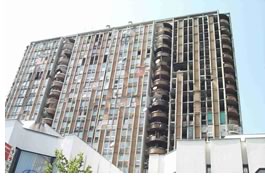 I
lived and worked at Camp Eagle, a multinational base camp and the headquarters
for the U.S. Army in Bosnia near Dubrave Gornje, a village of about 1,000
people situated 30 minutes south, by car, from the country's fourth largest
town, Tuzla. Our center of operations was a former Yugoslav National Army
base. The existing buildings were substantial and well-constructed. Signs
warning of mines dissuaded people from investigating the overgrown and
wooded areas off to the side of the roads, even as they reminded me of
why I was there. Large trees and sloping hills softened the installation's
appearance despite the frequency of armored vehicles traversing the roads
and helicopters regularly patrolling low along the boundaries.
I
lived and worked at Camp Eagle, a multinational base camp and the headquarters
for the U.S. Army in Bosnia near Dubrave Gornje, a village of about 1,000
people situated 30 minutes south, by car, from the country's fourth largest
town, Tuzla. Our center of operations was a former Yugoslav National Army
base. The existing buildings were substantial and well-constructed. Signs
warning of mines dissuaded people from investigating the overgrown and
wooded areas off to the side of the roads, even as they reminded me of
why I was there. Large trees and sloping hills softened the installation's
appearance despite the frequency of armored vehicles traversing the roads
and helicopters regularly patrolling low along the boundaries.
After years of designing affordable housing and basic modular units, I lived inside one: an 8-foot by 24-foot metal shipping container. It was comfortable, but basic. The walls and ceiling were white metal with two bright fluorescent fixtures overhead and conduit running along the walls and ceiling.
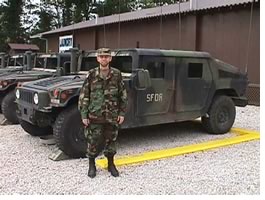 Even
as a civilian, I was required to wear the U.S. Army battlefield camouflaged
uniform and combat boots, rather than the regular uniform of trousers,
green shirt, and tie to work, meetings, and meals. My flak vest and Kevlar
helmet sat next to my desk and were required for any travel.
Even
as a civilian, I was required to wear the U.S. Army battlefield camouflaged
uniform and combat boots, rather than the regular uniform of trousers,
green shirt, and tie to work, meetings, and meals. My flak vest and Kevlar
helmet sat next to my desk and were required for any travel.
Camp Eagle
The flight into the country on a C-130 military troop transport aircraft
offered the first indication that I should prepare myself for an arduous
tour of duty and a unique experience. There were no passenger seats; only
webbed benches and canvas straps. The crew chief advised us that the pilot
would take evasive action if he received report of a threat at our destination.
He said if we saw the crew don their helmets, we should be sure to have
our seat belts securely fastened. Earplugs abated the engines' loud
roar. The warnings proved pertinent as we approached our destination—the
pilot began a rapid descent and then followed the valley, flying the heavy
multi-engine propjet just above the trees. The plane banked sharply, swerving
through the wooded hillsides at high speed. Later, I learned that it had
been a combat approach to evade being shot.
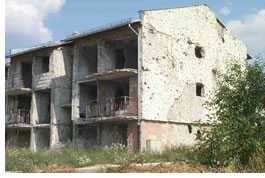 Our
office sat at the edge or "the wire" of the camp, where concertina
wire and concrete barriers formed the perimeter. A window allowed me to
hear the occasional rooster call, the infrequent vehicular traffic, and
the call to prayer from the numerous mosques five times a day. Through
its sniper screen, I could see houses on the other side of the road. Many
evenings the light cast a beautiful orange glow on buildings and trees.
Long shadows filled in between strong colors. I would have liked to walk
along streets, homes, and shops, but could only gaze through the fence
at the activity outside the camp. In the evenings the music from a café
across the street kept me company while I worked at my desk.
Our
office sat at the edge or "the wire" of the camp, where concertina
wire and concrete barriers formed the perimeter. A window allowed me to
hear the occasional rooster call, the infrequent vehicular traffic, and
the call to prayer from the numerous mosques five times a day. Through
its sniper screen, I could see houses on the other side of the road. Many
evenings the light cast a beautiful orange glow on buildings and trees.
Long shadows filled in between strong colors. I would have liked to walk
along streets, homes, and shops, but could only gaze through the fence
at the activity outside the camp. In the evenings the music from a café
across the street kept me company while I worked at my desk.
I supervised 10 Bosnian architects, engineers, and administrative personnel. Six American soldiers also served as part of the organization. We were required to clear projects in overgrown, wooded or unbuilt areas of possible mines and unexploded ordinance. This task necessitated extensive coordination with the de-mining team, military police, communications group, safety office, nearby occupants, and medical organizations about notifications, alternate vehicle traffic routes, aircraft overflights, and evacuations. We completed a number of clearing operations and prepared for others.
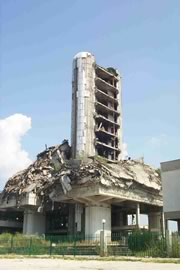 Weapons
everywhere
Weapons
everywhere
Nearly everyone carried a weapon. Enlisted soldiers slung rifles over
their backs and the officers carried holstered pistols on their web belts.
Walking down the aisles between tables in the dining hall proved difficult,
because machine guns were laid on the floor (they were not allowed on
the tables). At the dental clinic, I sat in the dentist's chair while
two machine guns hung on the wall next to me. In the fitness center, soldiers
placed pistols and rifles next to the exercise machines.
Given this atmosphere, it wasn't surprising that one of my first projects was to create additional space to store guns in an arms room. The existing arms room was connected with the mailroom. It was a practical adjacency because they both contained secure items, but it is an unusual U.S. Postal Service arrangement to have the M-16s stored next to the mailroom. While inspecting it one afternoon, the mail/arms room clerk told me about the firing range on the base. After living among so many weapons, it was good to get a hands-on sense of them and to shoot them at the indoor range, using carbon dioxide cartridges firing at a simulation screen.
Danger zone?
It was—and still is—difficult to gauge the level of safety or
danger. The U.S. government considers it a combat zone and we received
danger pay. We took extensive measures for protection and needed special
approval to leave the camp. Throughout Bosnia, hundreds of weapons and
caches continued to be discovered regularly, and reports of grenade or
other explosions outside the camp occurred almost weekly. On the other
hand, there was no open fighting and the NATO/SFOR soldiers were welcome
in town.
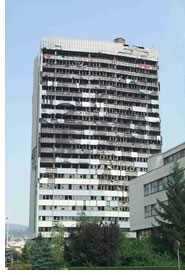 After
less than a week in the country, I had traveled out from "the wire"
for a meeting with a large American company building projects there and
in Kosovo and Afghanistan. Its offices were about a 45-minute drive south
next to a large UN compound. The scenery along the way was less developed
and poorer than I remember Yugoslavia from working in the country more
than two decades ago. We noted that many small shops and stores still
open at 8:30 Sunday evening. Our interpreter explained that shop owners
work every day, and as long as possible, to earn what they could. We also
saw many graveyards along the way, with white Muslim tombstones reflecting
brightly in the last light of the day.
After
less than a week in the country, I had traveled out from "the wire"
for a meeting with a large American company building projects there and
in Kosovo and Afghanistan. Its offices were about a 45-minute drive south
next to a large UN compound. The scenery along the way was less developed
and poorer than I remember Yugoslavia from working in the country more
than two decades ago. We noted that many small shops and stores still
open at 8:30 Sunday evening. Our interpreter explained that shop owners
work every day, and as long as possible, to earn what they could. We also
saw many graveyards along the way, with white Muslim tombstones reflecting
brightly in the last light of the day.
On my second Sunday after arriving in the base, we drove into the Republika Serpska to a Russian base. This is the Serbian part of Bosnia-Herzegovina and not the Republic of Serbia, a part of the country of Yugoslavia. A faded Russian flag flew over the small base. While Eagle Base housed a few thousand people, this one only has a small number of Americans and probably fewer than 80 Russians. Next to the camp is what is said to be the most polluting power plant in Europe. The nearby town is Ugljevik and the base is named Camp Ugly. It was.
We went there to inspect a plywood dining facility that was sliding into the river Modran. We crossed the previous front lines as we drove over the hills. Nearly all of the houses on the Bosnian side had been destroyed, and rough concrete frames were all that remained of most homes. In the countryside, houses had provided the sole source of shelter. The Serbs knew this and had shelled them. The Bosnians feared returning because of the threat of future fighting in a place so close to the border, as well as mines that still lay in the land.
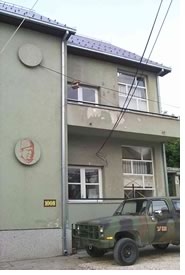 Preparing
to leave
Preparing
to leave
The chaplain organized a trip to Camp Jezevac, a refugee camp about 20
kilometers southwest of Eagle Base, to share pizza with elementary school
students for an end-of-year party. The children were friendly and curious.
They wondered why we hadn't brought cevapcici,
a food familiar to them. Many wrapped their pizza in napkins and saved
it, probably to share with their siblings and mothers at home.
As I looked forward to reuniting with my wife and sons in Germany, my time in Bosnia-Herzegovina ended with the same type of uncertainty with which it began. It was difficult to know when to tell my family to meet me in Europe. The Serbian border sits not far from the eastern end of the runway, and random variations were used in the flight operations to protect our security. But all in all, I appreciated the opportunity to work with the soldiers in Bosnia-Herzegovina, who are part of such an important and beneficial U.S. military mission. They are helping to maintain peace and security in a part of the world that badly needs this support
Copyright 2002 The American Institute of Architects. All rights reserved.
![]()
|
Mark Nedzbala, AIA, is a U.S. Army Corps of Engineers architect in Wiesbaden, Germany. He can be reached via email. |
|